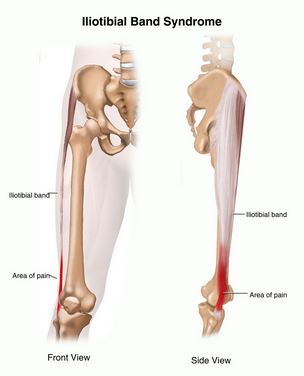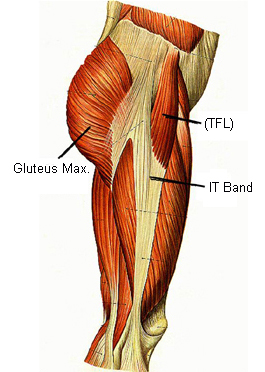 Alright, raise your hand if you know what the iliotibial (IT) band is and what it does. No? Good, you’re not alone! As we head into Spring and Summer with more people pursuing outdoor activities like running, cycling, and hiking, its important to discuss a common component of the body that people are often confused about: the IT band. Seriously, WTF is it? Is it a muscle? Is it an elastic band? Do I stretch it? Why the heck is mine so tight? Should I get mine removed? Ok… the last one I made up, please don’t have your IT band removed. But the rest are all fairly common questions we hear frequently. So lets set the record straight. Get ready for some knowledge bombs!
Alright, raise your hand if you know what the iliotibial (IT) band is and what it does. No? Good, you’re not alone! As we head into Spring and Summer with more people pursuing outdoor activities like running, cycling, and hiking, its important to discuss a common component of the body that people are often confused about: the IT band. Seriously, WTF is it? Is it a muscle? Is it an elastic band? Do I stretch it? Why the heck is mine so tight? Should I get mine removed? Ok… the last one I made up, please don’t have your IT band removed. But the rest are all fairly common questions we hear frequently. So lets set the record straight. Get ready for some knowledge bombs!
First, lets do what anyone would do and check what Wikipedia says:
“The iliotibial tract or iliotibial band (also known as Maissiat’s band or IT Band) is a longitudinal fibrous reinforcement of the fascia lata. The action of the ITB and its associated muscles is to extend, abduct, and laterally rotate the hip. In addition, the ITB contributes to lateral knee stabilization. During knee extension the ITB moves anterior, while knee flexion moves the ITB posterior. It originates at the anterolateral iliac tubercle portion of the external lip of the iliac crest and inserts at the lateral condyle of the tibia at Gerdy’s turbercle. The part of the iliotibial band which lies beneath the tensor fasciae latae is prolonged upward to join the lateral part of the capsule of the hip-joint. The gluteus maximus muscle and the tensor fasciae latae insert upon the tract.”
Ok, not a bad description but it doesn’t tell us everything we need to know. Lets break the description down a little bit. ‘Ilio’ refers to the iliac crest of the hip, where ‘tibial’ refers tibia bone of the lower leg. So ‘iliotibial’ gives us the location. The ‘band’ portion refers to big strap of connective tissue that connects from those two location points. Next, lets look at what connective tissue really is. Fascia is a connective tissue that surrounds muscles and other structures (bones, blood vessels and nerves) which provides structure to muscles and allows for a smooth, gliding movement over neighboring muscles. Much like ligaments and tendons, fascia is a flexible, woven structure and has a large capacity to resists forces. In fact, the IT band is so strong that it’s extremely difficult to change it’s length by method of foam rolling or stretching. So in the context of the “longituinal fibrous reinforcement of the fascia lata”, the IT band it is essentially a thickened portion of fascia connecting from the outside of your hip (overlapping with the gluteus maximus muscle and tensor fasciae latae (TFL) muscle), reaches down the outside of your leg, and attaches just below your knee cap. The TFL and gluteus maximus have an important biomechanical role with IT band. This is because they control the amount of tension on the IT band. So, methods like foam rolling your thighs or the length of the IT band, however good it might feel, may not be an effective method for preventing IT band syndrome. We’ll discuss more about this shortly.
Now lets break down the role of the IT band. It actually plays a critical role in stabilizing the knee. Why? Because is almost always in use. The IT band functions by stabilizing the knee both in extension (leg straight) and partial knee flexion (knee slightly bent). So, for activities like walking, running, hiking, and cycling for example, the IT band is constantly in use to help with lateral stabilization of the knee. If you’re doing one or more of those activities frequently, your IT band is definitely working to help keep you stable.
With the repeated flexion and extension of the knee, particularly in runners, pain can often develop and is commonly known as IT band syndrome. Because the IT Band tracks across the the outside of the knee it also rubs against part of your knee (lateral femoral epicondyle) which can lead to irritation, pain, thickening and inflammation of the tissue in the area. But what if you have pain at your hip or thigh? Well, it’s likely something else effecting you. Though IT band syndrome presents as knee pain, but the cause can vary greatly and are often a result of more than one cause. Factors such as anatomical features (leg length, amount of arch in your foot, etc), muscular asymmetries (weak or non-firing hip muscles), and exercise habits (poor maintenance of joint mobility and stability, excessive hill training with running) all play a role in your risk of developing IT band syndrome.
So what can you do to reduce your risk of IT Band related issues? Well, how about a good warm up for goodness sake! Far too often I speak with mid to long distance runners with chronic knee pain who’s warm ups consist of “that standing hip flexor stretch” and “some jumping jacks”. You’re running a half marathon from a cold start and you’re knees hurt, you don’t say? Honestly, the majority of IT band syndrome prevention relies largely on common sense and practices that we all know we should do: proper warm up movements and exercises to prime your muscles and joints for activity, proper cool downs to release areas of excessive tension (foam rolling appropriate muscles), incorporating corrective exercises to improve muscle imbalances and weaknesses (core and hip stability exercises), and limiting counterproductive training habits like excessive uphill and downhill running. Notice how I didn’t include stretching? That’s because there is little to no compelling research to support that stretching is effective with IT band Syndrome. If you have no idea how to carry out these methods, please, please, please see someone who can help guide you (kinesiologist, physiotherapist). This way you will receive a proper functional assessment and instruction through each of these preventative measures so you can master your body mechanics, movement, and performance while preventing injuries from developing. Trust me, your body will thank you for it!
On that note, I would like to wish you all a very happy Spring! The sun is out, go play outside! Just do me one favor: spread your new-found knowledge about the IT band! Spread it far and wide! Just don’t do it while you’re running up hill for 20Km with no warm up and poor body mechanics. THANKS!
Interested in training at Balance In Motion? Check out our list of services!
You can also check out our informative and entertaining content on Facebook by ‘Liking’ our page at https://www.facebook.com/pages/Balance-In-Motion/123672497655795, or follow us on Instagram at http://instagram.com/balancemotion#.







